| (2 intermediate revisions by the same user not shown) | |||
| Line 234: | Line 234: | ||
<ref>http://www.dot.ca.gov/trafficops/trucks/quickguide.html</ref> | <ref>http://www.dot.ca.gov/trafficops/trucks/quickguide.html</ref> | ||
General embedded | General embedded CO<sub>2</sub> in shipping by land | ||
80 g/tonne/km<ref> http://www.ics-shipping.org/docs/co2,</ref> | 80 g/tonne/km<ref> http://www.ics-shipping.org/docs/co2,</ref> | ||
| Line 249: | Line 249: | ||
Fuel efficiency 4.8 km/gal <ref>http://www.cert.ucr.edu/events/pems2014/liveagenda/25sandhu.pdf</ref> | Fuel efficiency 4.8 km/gal <ref>http://www.cert.ucr.edu/events/pems2014/liveagenda/25sandhu.pdf</ref> | ||
Carbon Intensity 10.15 kg CO<sub>2</sub> /gal <ref | Carbon Intensity 10.15 kg CO<sub>2</sub> /gal <ref>http://www.eia.gov/tools/faqs/faq.cfm?id=307&t=11</ref> | ||
==Next Steps== | ==Next Steps== | ||
Revision as of 05:12, 11 December 2016
This page is the compilation of a research project in partnership between Engr308 Technology and the Environment, The Sustainability Office, and Dining Services at Humboldt State University during Fall 2016. The client leads on this project are
- Morgan King, Sustainability & Waste Coordinator
- Katie Koscielak, Sustainability Analyst
- Ron Rudebock, Director of Dining Services
The objective of this project is to analyze and compare the effects of the HSU policy and pricing regarding mason jars and disposables in terms of its monetary costs, carbon dioxide emissions, and embedded energy. A secondary goal is to create a recommendation that would improve the overall functionality of the policy. Another goal was to create compelling comparisons for consumers.
Some background information:
- Lumberjack article on the mason jars
- Students Promoting ‘Kill the Cup’ Contest
- Sign from 2015 regarding single use coffee cups on campus.
Findings
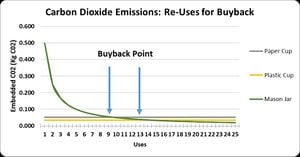
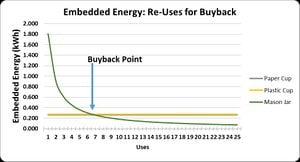
This study of Mason jars, paper cups, and plastic cups compared three metrics: carbon dioxide emissions, embedded energy, and cost. It was concluded that the materials used, transport of, and disposal of a single mason jar requires 1.81 kilowatt-hours of energy, is responsible for 0.509 pounds of carbon dioxide emissions, and are sold for $0.75. In comparison, a single paper cup is responsible for using 0.262 kilowatt-hours of energy, releasing 0.051 kilograms of carbon dioxide, and costs $1.00. A single plastic cup is responsible for using 0.273 kilowatt-hours of energy, releasing 0.035 kilograms of carbon dioxide emissions, and costs $1.50. In order to abate the embedded energy and carbon dioxide emissions incorporated in a Mason jar, the Mason jar must be reused 7 times (energy) and 10 times (carbon dioxide), rather than purchase and dispose of a paper cup. As for the plastic cup, a mason jar must be reused 7 times (energy) and 15 times (carbon dioxide).
| Mason Jar | Paper Cup | Plastic Cup | |
|---|---|---|---|
| Embedded Energy | 1.81 | 0.262 | 0.273 |
| Carbon Dioxide | 0.509 | 0.051 | 0.035 |
| Mason Jar Reuses
(Embedded Energy) |
n/a | 7 | 7 |
| Mason Jar Reuses
(Carbon Dioxide) |
n/a | 10 | 15 |
The calculations and assumptions used to obtain these results can be seen in further detail in this spreadsheet. The spreadsheet allows for others interested in performing a similar analysis to easily input values pertaining to their particular study area. It is our hope that with this information and the pre-assembled spreadsheet, other institutions will be able to reach similar compelling conclusions that have the potential to influence future policies.
Mason Jars
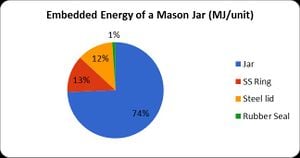
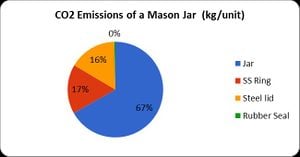
The Mason jars analyzed in this study were the 16 oz wide-mouth glass jars with a steel ring and rubber sealed, stainless steel lid. The jars were produced by the company Jarden Home Brands based out of Fishers, Indiana, and were transported to Humboldt State University in Arcata, California. The jars are purchased by the pallet for $0.59 per jar, and are sold for $0.75 each, generating a profit of $0.16 per jar. It was estimated that about 2% of all the jars purchased were thrown out, and 3% were recycled.
| Output | Embedded Energy | Carbon Dioxide Emissions |
|---|---|---|
| Materials | 1.49 kWh/jar | 0.39 kg CO2/jar |
| Transportation | 0.31 kWh/jar | 0.082 kg CO2/jar |
| Disposal | 0.007 kWh/jar | 0.04 kg CO2/jar |
| Total | 1.81 kWh/jar | 0.51 CO2/jar |
Paper Cups
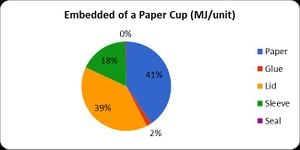
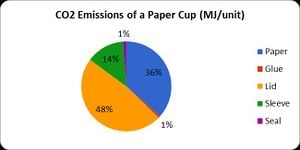
The paper cups analyzed in this study were the 16 oz disposable Karat Earth “ONE Earth” cups. These cups were produced by the company LolliCup based out of Chino, California, and were transported to Humboldt State University in Arcata, California. The cups are purchased by the pallet for $0.08 per cup, and are sold for $1.00 each, generating a profit of $0.92 per cup. It was estimated that 100% of all the paper cups purchased were thrown out.
| Output | Embedded Energy | Carbon Dioxide Emissions |
|---|---|---|
| Materials | 0.25 kWh/cup | 0.048 kg CO2/cup |
| Transportation | 0.004 kWh/cup | 0.001 kg CO2/cup |
| Disposal | 0.008 kWh/cup | 0.002 kg CO2/cup |
| Total | 0.262 kWh/cup | 0.051 CO2/cup |
Plastic Cups
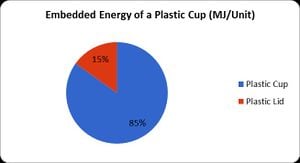
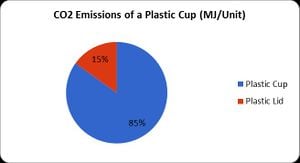
The plastic cups analyzed in this study were the 16 oz disposable Karat Earth PLA eco-friendly cups. The cups were produced by the company LolliCup based out of Chino, California, and were transported to Humboldt State University in Arcata, California. The cups are purchased by the pallet for $0.12 per cup, and are sold for $1.50 each, generating a profit of $1.38 per cup. It was estimated that 100% of all the plastic cups purchased were thrown out.
| Output | Embedded Energy | Carbon Dioxide Emissions |
|---|---|---|
| Materials | 0.26 kWh/cup | 0.031 kg CO2/cup |
| Transportation | 0.007 kWh/cup | 0.002 kg CO2/cup |
| Disposal | 0.006 kWh/cup | 0.002 kg CO2/cup |
| Total | 0.273 kWh/cup | 0.035 CO2/cup |
Comparisons
A number of comparisons have been made by each team which help understand the magnitude of the impacts of the policy change being analyzed in this report. These comparisons are represented as one or two lines of text on a relatable image, and are displayed in the gallery link below.
- insert gallery link*
Teams
TEAM 1
TEAM JAR-JAR BINKS
The Jarheads
FREE MASONS
Jar-Droppers
Meta Team
Research Synthesis
Embedded Energy, CO2, and Life Cycle Analysis Concepts
During the spring of 2016, Humboldt State University chose to promote mason jar reuse for coffee and beverages on campus a program that embodies Humboldt State’s commitment to sustainability. Humboldt State University in its commitment to reduce the carbon footprint on campus chose to be part of the Kill the Cup Campaign (a national campaign to end the use of disposable coffee cups) in order to create awareness and create an incentive for meeting its environmental mission. After the Campaign ended, WRRAP (Waste Reduction and Resource Awareness Program), Zero Waste Humboldt, and Humboldt State University’s Dining services began selling students mason jars to cut down the use of disposable coffee cups on campus. In 2010 it was estimated that the United States alone consumed around 2.3 billion paper cups ([1]). This literature review, will go over the embodied energy and CO2 emissions of the individual products, the energy and carbon impact of shipping of the products, and disposal of the products; and creating a total energy and carbon dioxide impact of the product once the product is bought. Embodied or embedded energy (EE) is defined as the energy used during the entire lifecycle of a product. For example, the EE of a mason jar or a disposable cup could include extraction and processing of raw materials, manufacturing, transportation, distribution, use, reuse, recycling and final disposal. EE calculations are used to conduct life cycle assessments (LCA). LCA is a well-explored concept and has been used as an environmental management tool since the late 1960’s. Menzies, Gillian F., Seyhan Turan, and Philip FG Banfill. "Life-cycle assessment and embodied energy: a review."( [2])LCA provides a tool for evaluating the relative environmental impact of various materials and calculates externalities otherwise excluded from pricing. These analyses allow for a comparison of products like the use of mason jars vs. disposable cups. Our LCA will include emissions and the EE of the materials and shipping. (United States D.O.E.). ([3])
Embedded Energy and CO2 Emissions in materials
- Mason Jars
"
| Material | Embedded Energy (MJ/kg) | Embedded CO2 (kg/kg) |
|---|---|---|
| Soda-Lime | 11 | .8 |
| Float Glass | 15.511 | 1.136 |
| Primary Glass | 15.00 | .86 |
| Secondary Glass | 11.50 | .55 |
| Fiberglass | 28.00 | 1.54 |
| Toughened | 23.50 | 1.27 |
"Not recycled: 8.4 kg CO2E per kilogram of glass
Recycled : 1.4 kg CO2E per kilogram of glass" [6]
Stainless steel lid: 56.7 MJ/kg (EE), 6.15 (CO2E) [7]
- Paper Cups
Paper: 66 (Mj/Kg) .031(kg CO2/kg)[8]
- Plastic Cups
Plastic: 107(Mj/Kg) 4.1 (kg CO2/kg) [9]
Embedded Energy and CO2 Emissions in Transportation
- Transport by sea [10]
6000 TEU Container Ship: .143 MJ/t/km
CO2 emissions: 11.1 g/t/km
1500000 ton bulk carrier: .027 MJ/t/km
CO2 Emissions 2.1 g/t/km
- Transport by Land
For Diesel Fuel Energy intensity: 135.8 MJ/gal[11]
Fuel efficiency 9.2 km/gal [12]
Carbon Intensity 10.15 kg CO2 /gal [13]
General embedded energy in shipping by land [14]
traveled by truck: 2.7 MJ/ t-km
Traveled by Truck: 180 (t CO2E / t-km x 10^6)
General embedded CO2 in shipping by land 80 g/tonne/km[17]
Embedded Energy and CO2 Emissions in Disposal
It was found that Humboldt State University sends it's garbage to landfills at Redding, CA and Medford, OR [18]
Humboldt State also sends their Recyclable material to Willits, CA ([19]) and Strategic Material in San Leandro, CA
Truck Average efficiency for Diesel was averaged at 3 miles per gallon but then converted to km instead of miles[20] which converted to 4.8 km/gal.
Diesel Energy intensity: 135.8[21]
Fuel efficiency 4.8 km/gal [22]
Carbon Intensity 10.15 kg CO2 /gal [23]
Next Steps
After completing the initial analysis, there are various alterations to the methods that could be made to create even more accurate results. These include:
- What are people's methods of washing the Mason jars? Is it significant enough to change the final outputs?
- How often are Mason jars actually reused compared to the number that are purchased simply due to the lower price?
- Include accurate reports of overall sales increases/decreases of Mason jars and disposables after implementation of the policy.
- Determine the volume of waste avoided by the implementation of a policy such as this.
- Calculate the embedded energy and carbon dioxide emissions in each unit produced by the manufacturing facilities, and the acquisition of the raw materials.
- Explore alternate options as to whether or not other viable products have the potential to reduce the embedded energy or carbon dioxide emissions from any of the beverage containers.
- Determine outlets for promoting and distributing this research to make it widely accessible.
References
- ↑ http://www.carryyourcup.org/get-the-facts/
- ↑ Proceedings of the Institution of Civil Engineers-Construction Materials 160.4 (2007): 135-144
- ↑ http://buildingsdatabook.eren.doe.gov/TableView.aspx?table=Notes/
- ↑ Ashby, M. (2012). Materials and the Environment - Eco-informed Material Choice.
- ↑ http://www.viking-house.co.uk/downloads/ICE%20Version%201.6a.pdf
- ↑ http://www.greenrationbook.org.uk/resources/footprints-glass
- ↑ http://www.viking-house.co.uk/downloads/ICE%20Version%201.6a.pdf
- ↑ https://www.dartcontainer.com/media/1889/ilea.pdf
- ↑ https://www.dartcontainer.com/media/1889/ilea.pdf
- ↑ http://www.sname.org/HigherLogic/System/DownloadDocumentFile.ashx?DocumentFileKey=8fc28849-71a2-4f98-886f-7b5e7b8819a8
- ↑ https://www.extension.iastate.edu/agdm/wholefarm/pdf/c6-87.pdf
- ↑ cta.ornl.gov/vtmarketreport/pdf/chapter3_heavy_trucks.pdf
- ↑ http://www.eia.gov/tools/faqs/faq.cfm?id=307&t=11
- ↑ http://pubs.acs.org/doi/pdf/10.1021/es702969f
- ↑ http://cta.ornl.gov/data/chapter2.shtml
- ↑ http://www.dot.ca.gov/trafficops/trucks/quickguide.html
- ↑ http://www.ics-shipping.org/docs/co2,
- ↑ https://humboldtgov.org/DocumentCenter/View/4203
- ↑ http://www.northcoastjournal.com/humboldt/the-recyclable-journey/Content?oid=2166785
- ↑ http://www.cert.ucr.edu/events/pems2014/liveagenda/25sandhu.pdf
- ↑ https://www.extension.iastate.edu/agdm/wholefarm/pdf/c6-87.pdf
- ↑ http://www.cert.ucr.edu/events/pems2014/liveagenda/25sandhu.pdf
- ↑ http://www.eia.gov/tools/faqs/faq.cfm?id=307&t=11